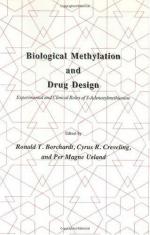|
This section contains 1,555 words (approx. 6 pages at 300 words per page) |

|
DNA methylation is a mechanism used to regulate genes and protect DNA from some types of cleavage. It is one of the regulatory processes that are referred to as epigenetic, in which an alteration in gene expression occurs without a change in the nucleotide sequence of DNA. Defects in this process cause several types of disease that afflict humans.
Biochemical Features
In methylation, a methyl group (-CH3) is added to position five of the cyto-sine ring in a DNA molecule (see diagram), attaching itself there by means of a chemical bond. For methylation to occur in DNA, certain conditions must be met. The cytosine must be linked to guanine, with the guanine occurring at the 3′ ("three prime") end of the DNA molecule, in a formation that, in scientific notation, is expressed as 5′-CG-3′ and is referred to as a CpG dinucleotide (with the "p" representing a phosphate group...
|
This section contains 1,555 words (approx. 6 pages at 300 words per page) |

|


